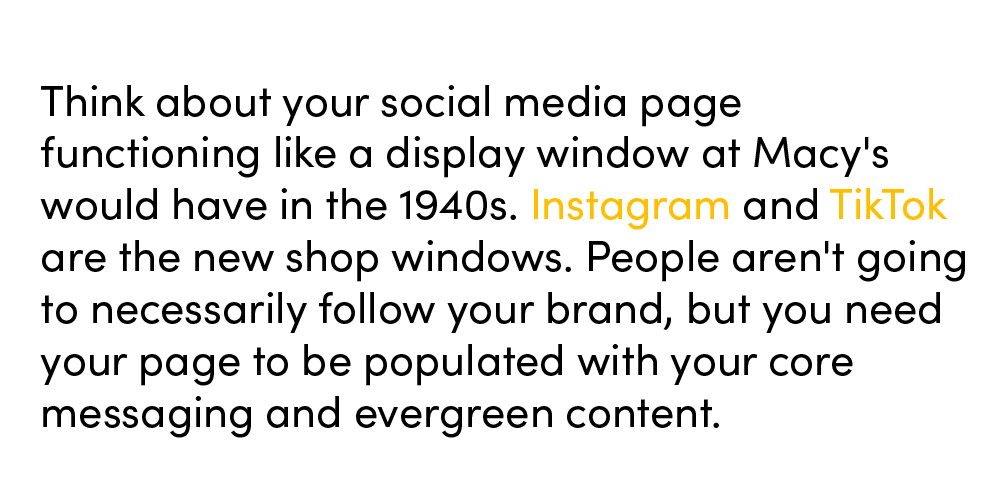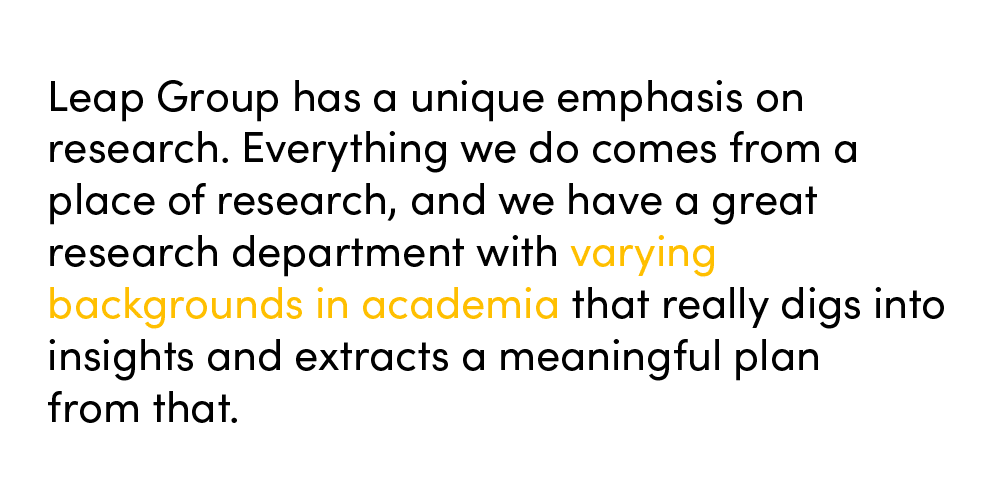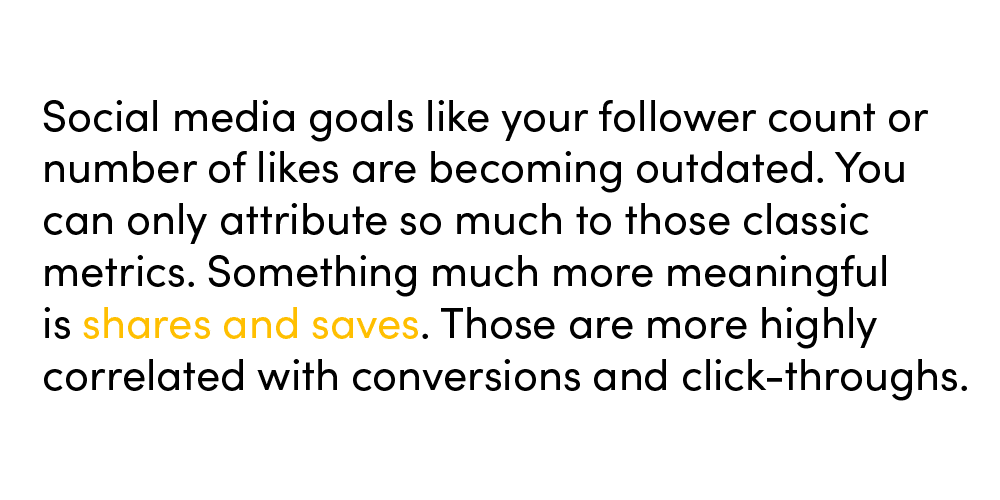In the past decade, the social media landscape has undergone a remarkable transformation, with significant impacts for brands and production studios. Platform algorithms and audience expectations continue to evolve, with many brands and organizations working under the belief that they must be constantly publishing polished and engaging content to succeed.
That’s not quite the whole story, as we learned from Taylor Cochran, Creative Content Producer for (spark) studio. An experienced industry insider, Taylor began managing the social media accounts for a global bourbon brand at the age of 25 before co-founding her own content studio, Neon Bites, which created short-form video storytelling promoting the people and brands making the Kentucky food and beverage industry great. Last year, Taylor decided she wanted to step into a more strategic role as a thought-leader in the space, which brought her to (spark), where she works with clients across industries on a local to national scale.
We recently sat down with Taylor to get her insights on the current social landscape and ideas about how brands can approach content creation with a more strategic and manageable approach. This is an edited and condensed version of our conversation.
How has the social media landscape evolved during your time in advertising and production?
When I started working in social media about 10 years ago, brands were still trying to figure out how to behave on social media. There was a lot of trial and error, and asking questions such as: Do our print advertisements work in this space? Should we be using smartphone photography for this major international brand? If we make it look more relatable, is that taking away from the brand’s prestige or opening it up to a new audience? For many brands, the goal was to make content feel like a friend’s. I was taking pictures on my cell phone and posting once or twice a week, and that was good.
Things have solidified more at this point. Social media users have advanced to the point that if your content isn’t good, they will call you out. Phone cameras have gotten better, and now there are microphones and ring lights, and it’s become an entire production to make content that’s engaging. To keep doing that over and over in an organic strategy feels overwhelming for a lot of brands. The algorithms have also evolved over the years, and most people think you must constantly post to be effective.
Is that not true? I think a lot of brands believe they need to be constantly posting.
If you have the bandwidth to do that, it won’t hurt. But a lot of brands overwhelm themselves believing it’s a must. Think about your social media page functioning like a display window at Macy’s would have in the 1940s. Instagram and TikTok are the new shop windows. People aren’t going to necessarily follow your brand, but you need your page to be populated with your core messaging and evergreen content.
When you begin approaching your pages that way, as curating a shop window and not trying to overwhelm yourself with becoming an influencer as a brand, it then becomes so much more manageable to develop a content production strategy that is digestible. You can take your foot off the gas a little and do quarterly shoots.

What about engagement with followers?
One of the best things brands could be doing on a regular basis is community engagement. That’s where they’re really going to see the benefit. If you can identify an employee that loves engaging with people and task them with social community management. Have them reply to comments, follow new profiles, create relationships, and develop a personality for the brand that you agree upon. That person can help the brand develop its own voice so that customers feel like they’re actually talking to the brand and not a robot. That’s going to be more effective than overloading the timeline with clearly branded content.
Are there brands that you think do the community aspect well?
One of the most popular case studies recently, and this is both content development and community management, is Duolingo. They’ve been funny and taken their mascot to insane places with content. Does it have anything to do with learning new languages? No. But it has made an icon out of their mascot and their brand presence. I’d be interested to see what it’s done for app downloads and engagement.
We’ve seen a lot of NFL teams commenting on the most random things you will ever see on TikTok. Wendy’s has always been incredibly active in the social space. From its early days on Twitter picking fights with McDonald’s, they’re still up to mischievous antics in the comments section. They were a front runner in being an absurdist brand voice and it’s really worked well for them.
How do you work with clients to develop a content production strategy?
For small to midsize businesses, I recommend developing a quarterly strategy. Look at your evergreen products and/or talking points and use those to develop a bank of content for the whole quarter at once. I’ve even worked with some brands where we would develop a content strategy for an entire year.
With many of the small restaurants I’ve worked with, we’ll plan quarterly photo and video shoots where they’ll give us every dish on the menu to shoot them at different angles. Then they have that library to post whenever they can to keep feeding their audience fresh, beautiful imagery until the menu changes again.
I’ve also done a lot of work with nonprofits. With those organizations, I recommend taking advantage of existing content and sharing articles that are relevant to your audience. That way, you let other sources do some of the lifting for you. If you see an interesting fact, you can make that into an infographic and put the source on it.
Look at as many profiles in your competitive set as possible. Really spend time with them and see how they’re engaging with their audience, and then develop a plan from there. There’s not a one-size-fits-all social media strategy.
Is competitive analysis something you provide for clients?
Yes. Leap Group has a unique emphasis on research. Everything we do comes from a place of research, and we have a great research department with varying backgrounds in academia that really digs into insights and extracts a meaningful plan from that. From there, they can pass it off to photo and video production, or graphic production, or whatever needs or insights may come from that.

Tell me more about Leap’s work with the Woody Williams Foundation.
The Woody Williams Foundation wanted a ground-up framework. I spent a week immersing myself in the history of Gold Star families, Gold Star wives, and different military non-profits they partner with. Essentially, I spent a week as a consumer to see what would be on their followers’ feeds, in addition to their own content.
Then I built a 60-page strategy document that included everything from platform best practices to what those meant for the organization in a specific action plan and content calendars. You don’t have to write out the content calendar all at once. You can take a calendar and put different colored dots on it that represent different content silos. I was trying to make the process as digestible as possible for someone whose entire job was not social media. At Leap, we understand those realities and really try to meet the client where they are.
I also encouraged the Woody Williams Foundation to capture smartphone videos whenever they have an event or something special happens in the organization. They see huge numbers from when they go live. Whenever a brand goes live, all their followers get notified. For Woody Williams Foundation, they didn’t have a huge following, but a huge percentage of it was clicking on that and tuning in and commenting live. That’s a great way to drive engagement and build brand loyalty.
When is it time for a brand to upgrade from smartphone photo and video to professionally produced content?
Both styles have a place. For brands and organizations that don’t have access to a production agency and are trying to produce content in-house, now is a great time to get comfortable being in front of the camera. Everything is favoring that very conversational human connection.
When it comes to bringing in a production crew, it’s smart to have a plan for what you’re doing that works across multiple tech points: content that will work on social media, can be used for conferences, put on your brand website, or even play on a screen in your waiting room. If you’re bringing in a production crew, it’s wise to think beyond social media. At Leap (spark), we really encourage that kind of condensed production approach. We’re going to be here for eight hours. We have these lights set up. How can we plan this shoot to get everything you will possibly need while we’re here?
Is that something your team can help clients plan out beforehand?
Absolutely. That’s one of the benefits of hiring a crew like (spark). We’ll help you get the most out of it. The first step is to be aligned with all your stakeholders about the goal. We usually recommend having a goal that is accomplishable in one setting. If you have one person that you’re interviewing, what is everything you could ask them that would provide good sound clips for all your future needs. If you’re interviewing the CEO, come to the table with a wish list. What do we really want from this? From there, it’s easier for us to take that and plan around it for what’s realistic.
What are some examples of effective social media goals?
Social media goals like your follower count or number of likes are becoming outdated. You can only attribute so much to those classic metrics. Something much more meaningful is shares and saves. Those are more highly correlated with conversions and click-throughs. If you’re creating content that people organically want to share to their own audiences, you are doing a great job. If you see that share button or the save button, you’re creating useful content.

Another good practice is to constantly audit yourself by putting yourself in the headspace of a new viewer or audience member. If you go to your page, does everything above the fold show your brand or organization in the light that you want it to? Is it engaging? Is it up to the quality that you want it to be?
I don’t think the goal should be just constantly creating content for creating content’s sake. The best you can do is have a meaningful goal that aligns with your brand goals internally. What are you focusing on? How can you tell that story? How can you keep calling back to that story? And you go from there. It’s that simple — and that much of a challenge to do it well.